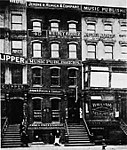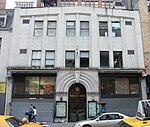Weber and Fields' Broadway Music Hall
1892 establishments in New York (state)1917 disestablishments in New York (state)Buildings and structures demolished in 1917Cinemas and movie theaters in ManhattanDemolished buildings and structures in Manhattan ... and 3 more
Demolished theatres in New York CityFormer Broadway theatresFormer theatres in Manhattan
Weber and Fields' Broadway Music Hall, sometimes simplified to Weber and Fields' Music Hall, was a Broadway theatre located in Manhattan on 29th Street near the corner of 29th and Broadway going towards Sixth Avenue. It was the resident theatre of comedy duo Joe Weber and Lew Fields from 1896 through 1904; with the pair starring in numerous original high energy musical farces mounted at that theatre.
Excerpt from the Wikipedia article Weber and Fields' Broadway Music Hall (License: CC BY-SA 3.0, Authors).Weber and Fields' Broadway Music Hall
Broadway, New York Manhattan
Geographical coordinates (GPS) Address Website Nearby Places Show on map
Geographical coordinates (GPS)
| Latitude | Longitude |
|---|---|
| N 40.746388888889 ° | E -73.989027777778 ° |
Address
Virgin Hotel
Broadway 1227
10001 New York, Manhattan
New York, United States
Open on Google Maps







